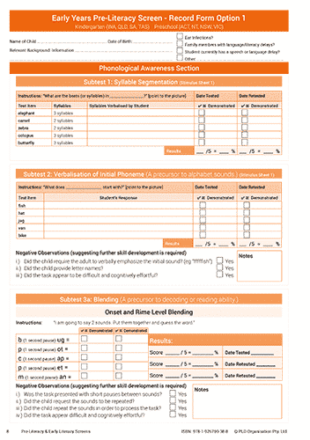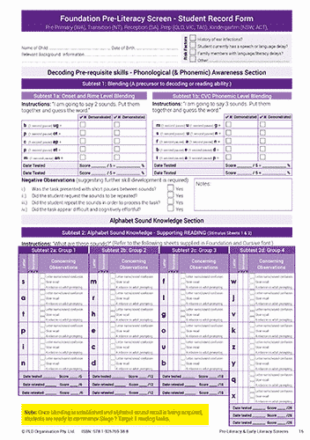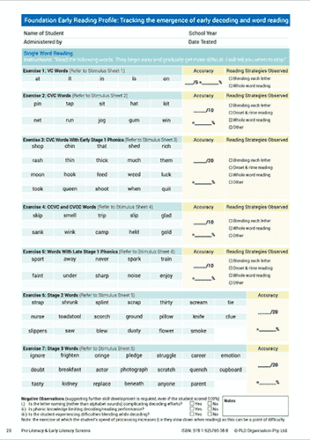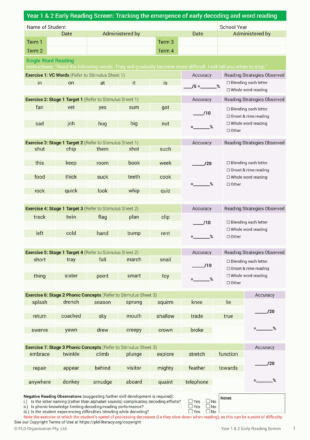We anticipate at PLD that all schools will have reduced attendance at the beginning and possibly throughout Term 2. As each week in the school year is precious, the following general suggestions are outlined below to get the most out of your screening and teaching during this uncertain time.
Jump to:
Early Years

Refer to the 2020 full year overview located on page 6 in the ‘Whole School Literacy Plan’ booklet and the Early Years Assessment Schedule.
- Recommendation 1: In your home and school learning package progress immediately onto the Term 2 skill initial sound awareness (Refer to Activity 1). This skill is one of the most important Early Years skills to develop in semester one. This skill represents the beginning of synthetic phonics. As a positive, this skill enables students in semester two to acquire the alphabet sounds and phonemic blending. As a negative, the absence of this skill will directly complicate the semester two acquisition of the alphabet sounds and blending ability. It is essential that Early Years classes progress from syllables onto this most essential skill.
- Recommendation 2: Midterm present subtest 2: Verbalisation of Initial Phoneme from the Early Years Pre-Literacy Screen. This subtest should take 1 minute per student.
- Recommendation 3: Following the midterm screening, remember to enter the individual results onto the tracking sheets and then to create a class profile.
Foundation

Refer to the 2020 full year overview located on page 10 & 11 in the ‘Whole School Literacy Plan’ booklet and the Foundation Assessment Schedule.
- Recommendation 1: In your home and school learning package Foundation, students should be starting to decode regular CVC words (Refer to Activity 2). Realistically, in each class, there will be students who require further instruction in pre-reading skills and others that are ready for early reading activities. For the students attending school, it is recommended that they are presented with Exercise 1 and 2 (VC & CVC Words) from the Foundation Early Reading Profile to determine if the introduction of a reading program is appropriate and also the type of reading material required.
- Recommendation 2: For the students who are unable to score 30-60% in Exercise 2, continue to track and target pre-literacy skills through the presentation of Ex 1b, Ex 2, Ex 3 & 4 on the Foundation Pre-Literacy Screen. These subtests should take no more than 3 minutes per student.
- Recommendation 3: Following the screening, remember to enter the individual results onto tracking sheets and then to create a class profile.
Tip: Take-home reading books should commence in Term 2. Remember, for the most significant gains in reading acquisition, Foundation students should be receiving decodable reading books (rather than whole-language leveled reading books). Make sure you have sufficient stocks of evidence-based reading books ready for distribution within Term 2.
Year 1 & 2

Refer to the 2020 full year overview located on page 17 & 18 in the ‘Whole School Literacy Plan’ booklet and the Year 1 & 2 Assessment Schedule.
- Recommendation 1: If at the end of Term 1 the spelling placement test was not presented, all students attending in Term 2 will require the presentation of the ‘End of Term 1 Review’ in the Phonic and Sight Word Placement Test.
- Recommendation 2: Once marked, remember to enter the individual results onto the tracking sheets and then to create a class profile.
- Recommendation 3: Most Year 1 students (plus the Year 2 students still operating at a Stage 1 level) require decodable reading material, rather than leveled whole-language readers. The following screen is to be presented to determine if students still require decodable reading books and the level of reading books required: Early Reading Profile Year 1 & 2.
Tip: The newly released Structured Synthetic Phonics Time-Savers Stage 1 & Stage 2 book may be of interest to reduce your preparation time.
Year 3, 4, 5 & 6

Refer to the 2020 full year overview located on page 16 & 22 in the ‘Whole School Literacy Plan’ booklet and the Year 3, 4, 5 & 6 Assessment Schedule.
- Recommendation 1: If at the end of Term 1 the spelling placement test was not presented, all students attending in Term 2 will require the presentation of the ‘End of Term 1 Review’ in the Phonic and Sight Word Placement Test.
- Recommendation 2: Once marked, remember to enter the individual results onto the tracking sheets and then to create a class profile.
- Recommendation 3: If students are still operating at a junior primary reading level, then the following screen will assist in determining the type of decodable and phonic rich reading books required: Early Reading Profile Year 1 & 2.



 print
print







